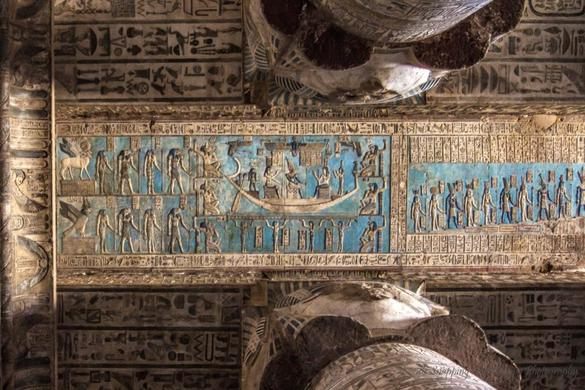Temple of Hathor in Dendera
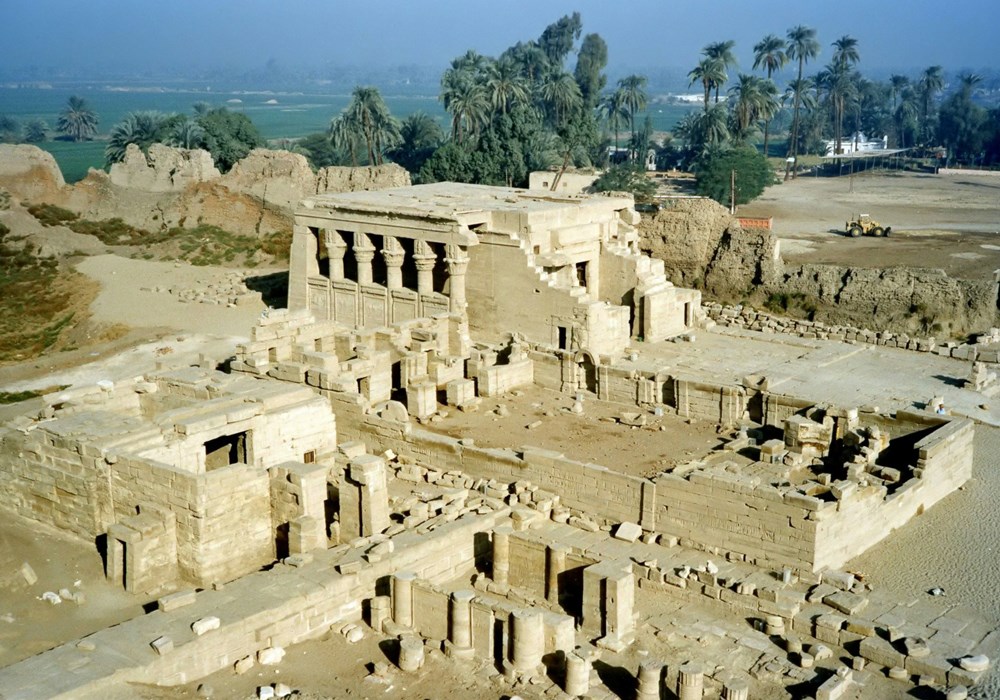
In the Pharaonic Era, Dendera (Ancient Egyptian: Tantere) was the capital of Egypt's sixth Nome. Today, Dendera is a small town in Upper Egypt, in Qena Governorate, about 550 Km to the south of Cairo and 70 Km to the south of Luxor. Dendera is famous for its well-preserved temple, of the Ptolemaic Period, dedicated to goddess Hathor. Side by side to the temple are many tombs from the Old Kingdom and around it are many buildings (such as the Temple of lsis, Ptolemaic and Roman birth houses, a Coptic church, and a sacred lake). It is one of the popular tourist attractions because it encloses numerous magnificent temples and monuments and also can be reached by plan since it locates few meters away from Luxor International Airport.
Attested by some historical as well as archeological testimonies is the fact that in the site of the actual temple there were previous sacred buildings dedicated to goddess Hathor (worshipped as a cow-deity in the Egyptian pantheon). The actual temple was begun in the first century BC and its construction works continued until 20 BC. The temple's major part was finished under the reign of Cleopatra VII. There are many blank cartouches that testify the political instability of the last years of the Ptolemaic Dynasty. Similar to the plan of Edfu is that of the Temple of Hathor, since Hathor was considered the wife of Horus. Six Hathor-headed columns with a eighteen sistrum-shaped structure are separated by both decorated curtain walls and the central door form the façade of the temple, which is 35 meters wide and 12.5 meters high. Above the façade is carved a still-readable Greek text that glorifies the Emperor Tiberius Caesar.
- The Vestibule of the Temple of Hathor at Dendera
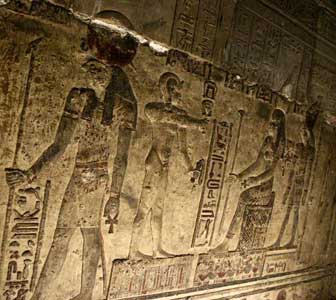
On getting inside the temple, one can admire the eighteen sistrum-shaped columns that form a huge forest, that normally symbolize the original marshes were Ancient Egyptian gods were born. The structure is well reserved and almost intact. Magnificently, one can immerse in graceful feelings caused by the intentional play of lights and shades by which all the temples are exhibited. On the vestibule's walls appear traditional scenes depicting the pharaoh performing the worshipping rituals as a king of the Upper and Lower Egypt as well as the consecration of the temple to Hathor. Other scenes of offerings to many gods of the Egyptian pantheon can also be admired, though their faces– like in many other temples– were destructed by the early Christians. Like those of other buildings of the Ptolemaic Era, the reliefs are of deep, yet, they are of less quality than the Pharaonic ones. In the ceiling, one can eye some of the best astronomical scenes showing the sky goddess, Nut and the signs of the zodiac.
Hypostyle Hall of the Temple of Dendera
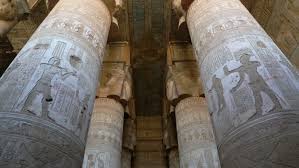
The Hypostyle Hall of the Temple of Hathor is formed by two rows of three columns, with granite bases. On the columns, a King is worshipping many deities by whom he is blessed. Dedicating the Temple to Hathor and Horus, the scenes on the walls are almost the same as those on the Vestibule. Around the Hypostyle Hall are six small chambers meant for storing the offerings and the provisions of the temple.
The Antechambers of the Temple of Hathor
Lying directly after the Hypostyle Hall of the Temple of Hathor is the First Antechamber, which is called the 'Hall of Offerings'. It once had a wooden door of double leaves. Here, the scenes are of worshipping Hathor, Horus and other deities. On both sides, there are two stairways leading to the roof of the temple. The Second Antechamber is called the 'Hall of the Divine Ennead', the nine gods that form the Pantheon of Heliopolis: Ra, Shu, Tefnut, Geb, Nut, Isis, Osiris, Seth and Nephthys. This antechamber is surrounded by small rooms used for storing the temple's provisions. On the right side lies the treasury, which contains a small court with a staircase leading to a chapel dedicated to The Union of Hathor and Ra on the New Year's Day. On the room's ceiling, visitors can set their eyes at Nut, the sky goddess giving the shape of the horizon with her body.
The Sanctuary of the Temple of Hathor
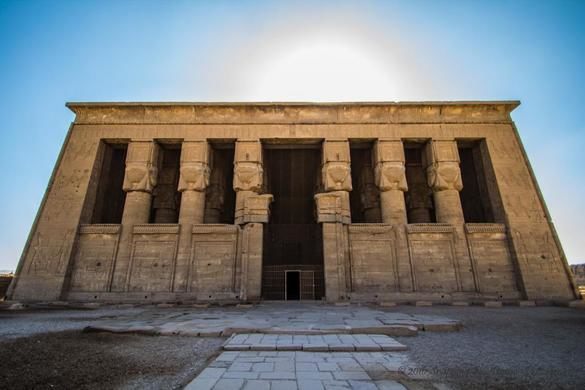
Leaving the Second Antechamber, one finds the Sanctuary of the Temple of Hathor surrounded by 11 small rooms. In this sanctuary, the sacred barks of Hathor, Horus, their son Harsmoutus and Isis were kept. The Sanctuary was the most sacred place of the temple and it was only reserved to the High Priest and the King. To the right of the Sanctuary stands the staircase that leads to one of the twelve subterranean crypts with well painted walls. According to some tourist guides, here lies the tomb of Cleopatra.
The Roof and Rear Wall of the Temple of Hathor
The roof of the Temple of Hathor is reached through taking the left stairs in the first vestibule. The walls of the stairwells are decorated with scenes depicting of the priests bearing statues of Hathor on the occasion of the New Year's ritual and festival processions. From the room, one can admire fantastic views of the surrounding archeological site, the desert and the fields. In the right rear corner of the roof stands a small wood-roofed kiosk that was built by Ptolemy XII, with twelve Hathor-headed columns. In the front of the temple, there are two sanctuaries dedicated to Osiris, the ceiling of one of which had been once decorated by one of the most beautiful zodiacs that was stolen and now exposed in the Louvre Museum and in its a replica is put. On the wall of the neighboring room, Osiris is depicted lying on a bed, while Isis, as a bird is flying over him to receive his semen. On the rear wall of the temple, one can behold colossal reliefs of Cleopatra and her son Caesarion standing before Hathor and other deities.
The Temple of Isis and Coptic
Church in the Temple of Dendera
The Temple of Isis lies behind the grand Temple of Hathor in Dendera. Taking blocks from earlier buildings, Emperor Augustus built the temple in a small construction with a small but interesting sacred lake. Beside the Roman Birth House and in front of the grand Temple of Hathor, lies the Coptic Church. Its ruins date back to the fifth century.
The Birth House in Dendera
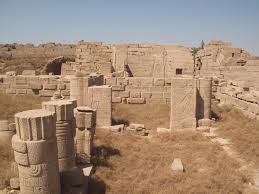
The large Birth House at Denderah lies in front of the Temple of Hathor. It was begun by Augustus Octavius; however, cartouches and decorations of Trajan and Hardin are seen. It was dedicated to Harsmoutus (the son resulting from the marriage of Hathor with Horus). For that reason, scenes of many deities related to his birth –like the dwarf god Bes and the frog goddess– are to be beheld. Between the church and the Temple of Hathor stands another birth house belonging to the late Pharaonic Era, built by Nectanebo I with some contributions from The Ptolemies.
